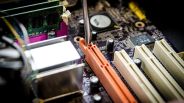As NASA's New Horizons steadily makes its way to the Pluto system, the spacecraft has confirmed that there is methane on the planet.
Astronomers on earth first observed that there was methane in Pluto in 1976, but it was only now that the chemical compound's presence was confirmed, thanks to an infrared spectrometer aboard the New Horizons. Will Grundy, the leader for New Horizons' Surface Composition team, said that the spacecraft will next help in determining if methane is present in other areas of the planet in different forms or composition.
Methane is a colorless, odorless glass present in both under the ground and in the atmosphere of the Earth. On Pluto, the gas is primordial, meaning it came from the solar nebula that formed the solar system billions of years ago.
Aside from confirming the presence of methane in Pluto, the New Horizons spacecraft is also busy capturing images of the planet and its moons through the Long Range Reconnaissance Imager camera. Its latest set of images were taken from May 28 to June 25 and feature Pluto and Charon, the planet's largest moon.
The images showed that the planet has a strong-contrast surface with a bright northern hemisphere prominent and a non-continuous band of darker materials running the length of its equator. As for Charon, the images paint the moon as having a dark polar region, with variations in brightness at lower latitudes.
New Horizons will also be observing the sun set and rise on Pluto when it flies by the planet on July 14 so it is preparing for the task by making critical observations. Observing the sun set and rise is a way to examine the composition of the atmosphere on Pluto as the planet will be illuminated from behind by a powerful light source. A test observation of the sun was carried out by the spacecraft's Alice ultraviolet imaging spectograph from 3.1 billion miles away.
The spacecraft is now less than 11 million miles away from its destination. All systems are operating normally, signifying that New Horizons is in the pink of health and is more than ready to complete its mission.
New Horizons is a part of NASA's New Frontiers Program. The spacecraft was designed, built and operated by the Applied Physics Laboratory at the Johns Hopkins University, while the Southwest Research Institute leads payload operations and the science team. The APL also manages the mission for NASA's Science Mission Directorate.
ⓒ 2025 TECHTIMES.com All rights reserved. Do not reproduce without permission.




